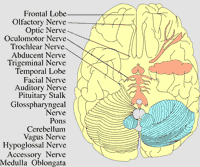Friday, May 04, 2007
Dissecting Marketing Forensics
 I just came across an intriguing banner ad offer for a webinar titled "Multichannel Forensics: Understanding How Customers Interact with Advertising, Products, Brands and Channels" being given by Kevin Hillstrom and it made me think - what exactly is multichannel or marketing forensics? The marketer in me likes the phrase - it has a very scientific ring to it - and perhaps some clients might even think it sounds good when they pitch to their bosses for budget money for a "multichannel forensics initiative." After registering for the webinar (yes, I signed up to see what it's all about), I decided to do a little research into how this term is being bandied around the Web.
I just came across an intriguing banner ad offer for a webinar titled "Multichannel Forensics: Understanding How Customers Interact with Advertising, Products, Brands and Channels" being given by Kevin Hillstrom and it made me think - what exactly is multichannel or marketing forensics? The marketer in me likes the phrase - it has a very scientific ring to it - and perhaps some clients might even think it sounds good when they pitch to their bosses for budget money for a "multichannel forensics initiative." After registering for the webinar (yes, I signed up to see what it's all about), I decided to do a little research into how this term is being bandied around the Web.
As far as search engines go, Google had 933 hits for the quoted term "multichannel forensics" and most seemed related to marketing data mining. The use of "marketing forensics" was somewhat less common with only 170 hits and one of them for a company of that name doing marketing-ish things to increase product sales. In the blogosphere, Technorati lists 27 posts mentioning "multichannel forensics," and only one relevant post for "marketing forensics" (as of this writing), so the coinage of these phrases is probably relatively new and/or obscure. In most instances it seems the terms are used merely as a sexier alternative to customer intelligence.
But what should "marketing forensics" mean, especially if we hope clients have a more understanding response to its use than a quizzical 'huh?'
Paraphrasing somewhat from Kevin Hillstrom's whitepaper "An Introduction to Multichannel Forensics" a place to start might be:
Multichannel Forensics are the methods, made up of a series of analyses, that are applied to a multichannel environment to help us understand the complex behavior of how customers interact with products, services, brands, and channels.
That seems pretty much in line with how The American Heritage Dictionary defines forensics:
- The art or study of formal debate; argumentation.
- The use of science and technology to investigate and establish facts in criminal or civil courts of law.
The use of "science and technology" to uncover customer insight is key - the importance of having a method and means to measure how customers interact with your business cannot be overstated. The next trick is maintaining and integrating these processes across multiple channels so that a comprehensive picture of the customer can be captured. And don't forget about the "argumentation" part: there needs to be plenty of upfront discussion and agreement about what needs to be measured as well as what those measurements are. Everyone defines success differently.
Technorati Tags: b2b, demand creation, leads, marketing, marketing forensics, multichannel


